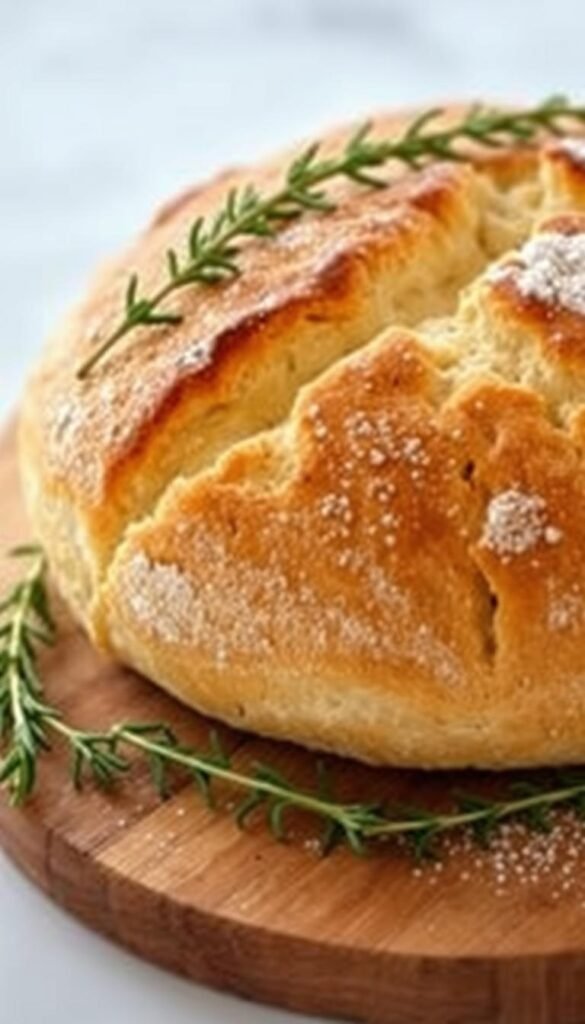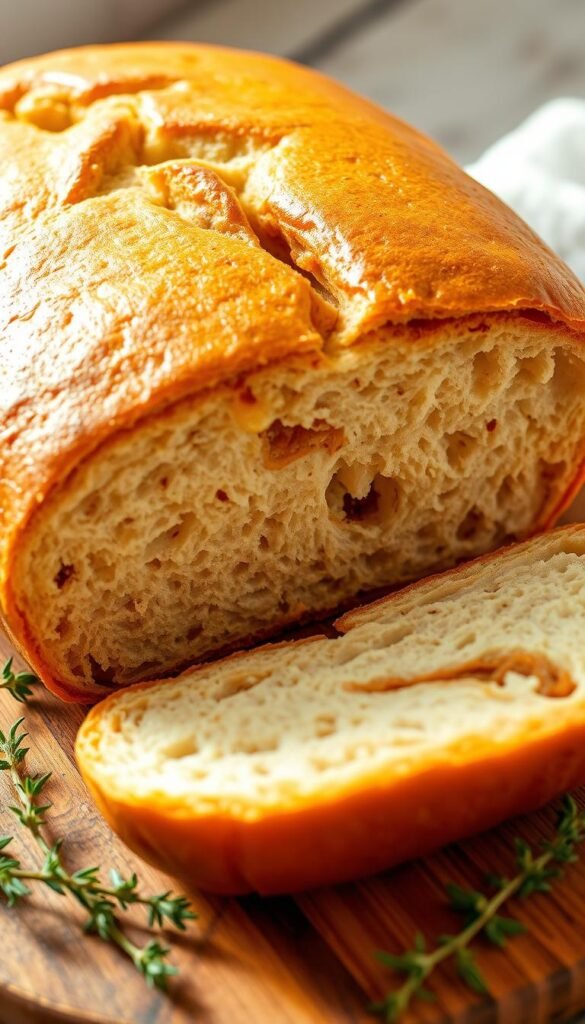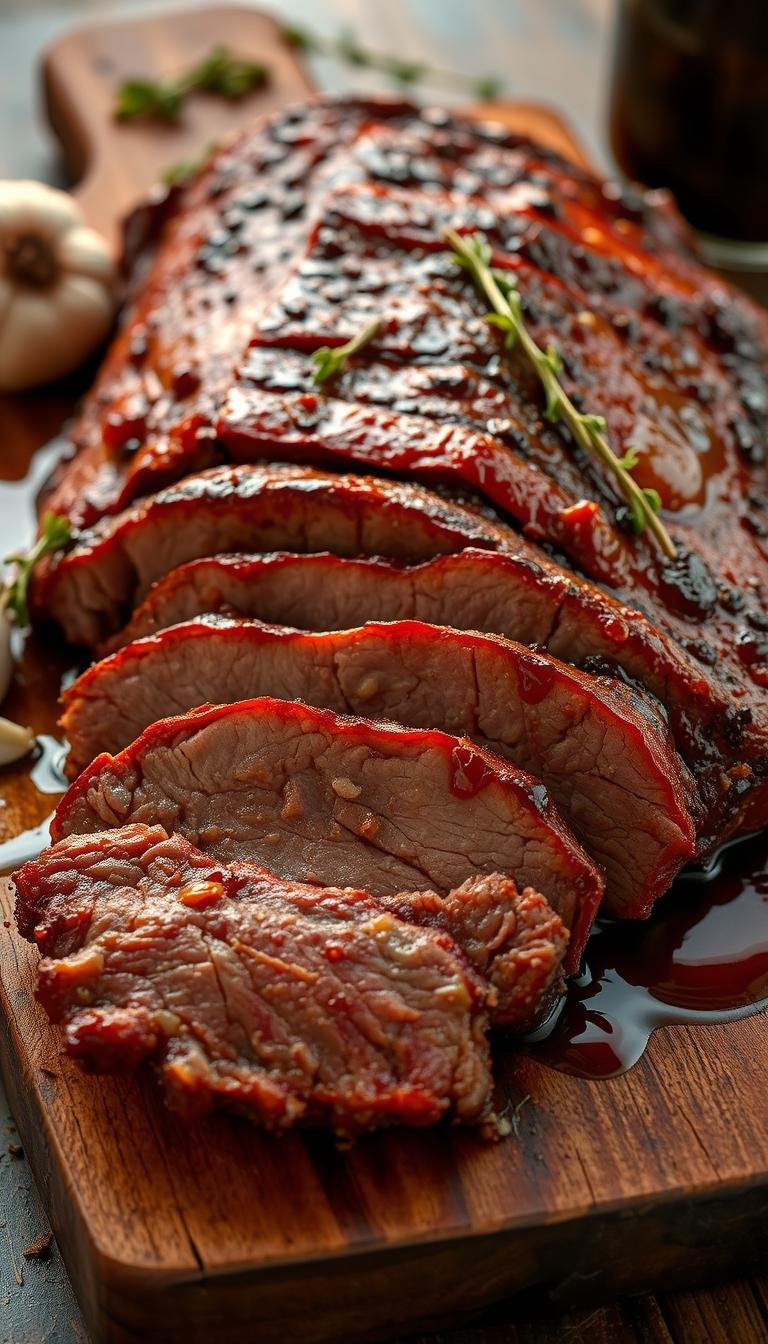25 Quick & Easy Dutch Oven Bread Recipes
Baking artisan bread at home is now easier than ever. Dutch oven baking makes it simple to get a crusty loaf. You can make a tasty, homemade bread just like your favorite bakery.
Baking Dutch oven bread is a big change for bread lovers. It uses a Dutch oven’s closed cooking space. This makes an easy bread recipe that looks and tastes great.
Key Takeaways
- Discover 25 simple and delicious artisan bread recipes using a Dutch oven.
- Learn the basics of Dutch oven baking for perfect loaves every time.
- Explore recipes tailored to various dietary needs and preferences.
- Master the technique for achieving a crackling crust and tender interior.
- Minimize hands-on time while maximizing flavor and texture.
The Magic of Dutch Oven Bread Baking
Dutch oven bread baking is special. It makes home bakes taste like bakery bread. A Dutch oven helps get that perfect crust and soft inside.
Why Dutch Ovens Create Superior Crusts
Dutch ovens make great crusts. They trap steam, which is key for a crispy crust. The Dutch oven’s closed space helps the dough rise better.
This makes the bread taste better and feel good to eat. The cast iron Dutch oven keeps heat even, which is important for a well-baked loaf.
The magic happens through the Maillard reaction. It’s a chemical change that happens when dough heats up. This reaction gives bread its flavors and colors. By controlling this, bakers can make their bread even better.
Essential Equipment for Perfect Results
To get perfect bread, you need the right tools. First, you need a good high-quality Dutch oven. You can choose between cast iron or enameled. Cast iron keeps heat well, and enameled is easy to clean.
You also need parchment paper, a bread lame for scoring, and heat-resistant gloves. These tools help make the baking process better.
Choosing the right Dutch oven size is important too. A bigger one lets dough expand more. But, it needs careful handling to avoid accidents. The Dutch oven should handle high heat well and spread it evenly.
Mastering the Basics: Dutch Oven Bread Techniques
Dutch oven bread baking is an art. It needs basic yet important techniques. To get the perfect loaf, you must understand preheating, dough handling, and storage.
Understanding the Preheating Process
Preheating is key in Dutch oven bread baking. Heat the oven and Dutch oven to 450-500°F for 30-45 minutes. This makes the Dutch oven hot for a perfect crust. Proper preheating is vital for a great rise and crust.

Proper Dough Handling Tips
Working with dough can be tough, especially with high-hydration doughs. Use gentle shaping and the right tools to avoid deflating. When moving the dough to the hot Dutch oven, use parchment paper or a peel to avoid burns. Careful handling helps the dough keep its shape and rise well.
Scoring, Steaming, and Baking Times
Scoring the dough lets it expand in a controlled way, making the crust look better. Adding steam early in baking helps the crust too. Baking times depend on the loaf size and type, but usually, it’s 25-40 minutes. Knowing these details is key for the right texture and look.
Cooling and Storage Guidelines
Cooling the bread right is important for its texture. Let it cool completely on a wire rack to avoid a soggy crust. For storage, use paper bags or bread boxes to keep it fresh. Proper storage helps prevent staling and keeps the bread fresh longer.
Classic Quick & Easy Dutch Oven Bread Recipes
Dutch oven bread recipes are a great way to start baking like an artist. They are key for anyone wanting to get better at making bread. A Dutch oven can make your bread taste like it was baked in a fancy oven, even if you don’t have one.
1. No-Knead Artisan White Bread
The No-Knead Artisan White Bread recipe is easy and doesn’t need much work. It was made famous by Jim Lahey. It uses time instead of kneading to make the bread soft and chewy.
To make it, mix 1 cup of warm water, 1 teaspoon of yeast, and 3 cups of bread flour. Just mix until it’s combined, then cover it. Let it rest for 24 hours. After shaping, bake in a hot Dutch oven for 30 minutes with the lid on, then 15-20 minutes without.
Lahey says, “The key to this bread is not in the kneading, but in the patience.” This method makes a beautiful, crusty loaf with a soft inside.
2. Rustic Sourdough Boule
The Rustic Sourdough Boule is a simple way to make sourdough bread in a Dutch oven. The Dutch oven makes the bread taste tangy and rich. Start by mixing 1 cup of sourdough starter with 3 cups of bread flour and 1 cup of water. Let it ferment for 4-5 hours, then shape it into a round. Bake in a hot Dutch oven for 25-30 minutes with the lid on, then 10-15 minutes without.
Using a Dutch oven for sourdough bread makes the crust golden and delicious.
3. Crusty French Country Bread
To make the perfect Crusty French Country Bread, you need a crackling crust and an open crumb. A poolish pre-ferment adds flavor. Mix 1 cup of poolish with 3 cups of bread flour, 1 teaspoon of yeast, and 1 cup of water. Let it rise for 2 hours, then shape and rest for another hour. Bake in a hot Dutch oven for 25-30 minutes with the lid on, then 15-20 minutes without.
The poolish pre-ferment makes the bread taste richer, following French baking traditions.
4. Simple Whole Wheat Bread
Making Simple Whole Wheat Bread in a Dutch oven is easier. Use a mix of whole wheat and bread flour for a lighter loaf. Mix 2 cups of whole wheat flour with 1 cup of bread flour, 1 teaspoon of yeast, and 1 cup of water. Let it rise for 4-5 hours, then shape and bake in a hot Dutch oven at 375°F for 35-40 minutes.
The Dutch oven’s even heat makes the whole wheat bread bake evenly, avoiding dense loaves.
5. Overnight Ciabatta Bread
Creating Overnight Ciabatta Bread means working with wet dough for big air pockets. Mix 1 cup of warm water, 1 teaspoon of yeast, and 3 cups of bread flour. Let it rest overnight, then shape and bake in a hot Dutch oven at 425°F for 20-25 minutes.
The secret to ciabatta’s airy texture is its wet dough. “It requires a gentle touch to preserve the delicate bubbles,” say expert bakers.
Herb and Cheese Dutch Oven Breads
Herb and cheese Dutch oven breads are tasty and pretty. They have fresh herbs and cheeses. The Dutch oven makes the crust crispy and the inside soft.

Rosemary and Garlic Focaccia
Rosemary and garlic focaccia is a tasty Italian bread. It’s great in a Dutch oven. The rosemary and garlic make it special.
Mix 2 cups of flour, 1/4 cup of olive oil, 2 cloves of minced garlic, and 2 sprigs of chopped rosemary into your dough. The Dutch oven makes it crispy on the bottom and soft inside.
- Prep Time: 1 hour
- Cook Time: 25 minutes
- Total Time: 1 hour 25 minutes
Cheddar and Jalapeño Bread
Cheddar and jalapeño bread is spicy and tasty. Use sharp cheddar and diced jalapeños for flavor. The heat and cheese mix well.
- Mix 1 cup of shredded cheddar into your dough.
- Add 1-2 diced jalapeños, depending on your desired level of heat.
- Bake in a preheated Dutch oven at 425°F for 25-30 minutes.
Olive and Herb Mediterranean Loaf
The Olive and Herb Mediterranean Loaf is full of flavor. It has olives and herbs like oregano, thyme, and rosemary. Mix them in gently for even flavor.
Complementary herb combinations like oregano, thyme, and rosemary evoke the essence of Mediterranean cuisine. Use pitted and chopped olives and fresh or dried herbs for a rustic and refined bread.
Sundried Tomato and Basil Bread
Sundried tomatoes add a strong tomato flavor. Fresh or dried basil adds a bright taste. Choose your basil based on your taste.
- Use 1/2 cup of rehydrated sundried tomatoes.
- Add 1/4 cup of chopped fresh basil or 2 tablespoons of dried basil.
Caramelized Onion and Thyme Bread
Caramelizing onions makes them sweet. This sweetness pairs well with thyme. Cook the onions slowly until they’re golden brown.
Mix 1 large caramelized onion and 2 sprigs of fresh thyme into your dough. It’s savory and aromatic.
Sweet Dutch Oven Bread Creations
Sweet bread lovers will be happy. Dutch ovens are great for making tasty sweet loaves. They’re perfect for baking sweet breads, from breakfast to desserts.

Cinnamon Raisin Swirl Bread
Cinnamon Raisin Swirl Bread is a favorite. Dutch ovens make it extra special. To get the swirl right, roll the dough well.
Soak raisins first to keep them moist. This makes the bread taste better. The Dutch oven’s steam makes the crust crispy and the inside soft.
Orange Cranberry Breakfast Loaf
The Orange Cranberry Breakfast Loaf is great for mornings. It has a fresh orange taste. Use fresh or dried cranberries, but balance their tartness.
The Dutch oven cooks it evenly. It gets a nice brown crust.
Chocolate Chip Brioche
Chocolate Chip Brioche is rich and delicious. Make the dough with butter and eggs carefully. Choose the right chocolate for the best taste.
The Dutch oven makes the brioche golden outside and soft inside.
Apple Cinnamon Bread
Apple Cinnamon Bread is cozy. It mixes cinnamon with apples. How you prepare the apples matters for the taste and texture.
The Dutch oven keeps the bread moist. This is important with apples.
Banana Walnut Bread
Banana Walnut Bread is loved by many. It’s important to mix the bananas right. Toasting nuts adds flavor and crunch.
The Dutch oven cooks it evenly. It gets a nice crust.
International-Inspired Dutch Oven Breads
Start a journey around the world with Dutch oven bread recipes. These recipes bring international flavors to your kitchen. Dutch oven baking is great for making artisanal breads at home. It’s easy to adapt many international bread traditions with it.
We’ll look at five different bread recipes from around the world. Each has its own special flavors and textures. You can make all of these with your Dutch oven.
Irish Soda Bread
Irish Soda Bread is a quick bread that uses baking soda to rise. The Dutch oven makes it perfect, with a crispy crust and soft inside. To get the traditional look, cut a deep cross on top with a knife or razor blade.
Adding caraway seeds or raisins can make it even tastier. It’s great with Irish stew, butter, or jam.
Tips for making Irish Soda Bread:
- Use buttermilk for a real flavor and soft crumb.
- Don’t mix the dough too much to avoid toughness.
- Make a deep cut on the bread for the cross.
German Rye Bread
German Rye Bread, or “Roggenbrot,” is dense and tangy. It often uses sourdough starter for flavor. The Dutch oven helps make a strong crust.
Working with rye flour needs some tricks. It has less gluten than wheat flour. Using a preferment or long fermentation times helps. Caraway seeds are traditional and add flavor.
Key to making German Rye Bread:
- Use a mix of rye and wheat flours for better texture.
- Add a sourdough starter or acidity for traditional taste.
- Let it ferment for a long time to get the full flavor.
Moroccan Semolina Bread
Moroccan Semolina Bread uses semolina flour for a unique taste and texture. Traditionally, it’s baked in a hot oven. The Dutch oven replicates this heat, making a bread with a golden crust and soft inside.
Shaping the dough into rounds or ovals and dimpling it are traditional steps. They add to the bread’s character.

Tips for Moroccan Semolina Bread:
- Use fine semolina flour for the best texture.
- Dimple the dough before baking for a traditional look.
- Serve with olive oil or use to scoop up tagines.
Indian Naan Bread
Indian Naan Bread is usually baked in a tandoor. But, the Dutch oven makes it easy for home bakers. To get the bubbles and char marks, preheat the Dutch oven very high.
Flavors like garlic, ghee, and nigella seeds are common in naan. Brushing with ghee or butter after baking adds richness.
Key to making Indian Naan Bread:
- Preheat the Dutch oven to a high temperature.
- Roll out the dough thinly for the right texture.
- Brush with ghee or butter after baking.
Italian Herb Focaccia
Italian Herb Focaccia has a dough that’s very wet. This makes it light and airy. The Dutch oven is perfect for baking focaccia, giving it a crispy crust.
Traditional steps include dimpling and topping with olive oil, herbs, and sometimes cheese. Mixing fresh and dried herbs is best for flavor.
Tips for Italian Herb Focaccia:
- Use a high-hydration dough for the right texture.
- Dimple the dough before topping and baking.
- Try different herb combinations.
Specialty Diet Dutch Oven Breads
Dutch oven breads are great for many diets. You can make gluten-free, vegan, or paleo bread. They taste good and feel right.
Gluten-Free Sandwich Bread
Gluten-free bread can be tricky. But, Dutch ovens make it soft and good for sandwiches. Use rice flour, tapioca starch, and potato starch. Add xanthan gum or psyllium husk for binding.
Make sure to hydrate well and handle the dough gently. This makes the bread soft and tasty.
Choose flours with iron and B vitamins for nutrition. Store gluten-free bread in a sealed container to stay fresh.
Low-Carb Almond Flour Bread
Almond flour is key for low-carb bread. Mix it with eggs, cream cheese, and salt. This makes a bread that’s low in carbs but full of protein and fats.
Don’t mix too much and use room temperature ingredients. This makes the bread better.
This bread is great for diets that are low in carbs. Try it with avocado or as a base for sandwiches.
Vegan Multigrain Bread
Vegan bread needs special ingredients. Use plant-based milks, flaxseed meal, and different grains. This makes a loaf that’s full of nutrition.
It’s packed with fiber and vitamins. Store it in a cool, dry place or freeze for longer.
Paleo-Friendly Cassava Bread
Cassava flour is perfect for paleo diets. Mix it with eggs, coconut oil, and salt. This makes a bread that’s paleo and tasty.
Be gentle when mixing. This helps avoid a dense bread.
Cassava flour is gluten-free and has carbs. Try it with almond butter or avocado.
Keto-Friendly Seed Bread
Keto bread needs the right mix of seeds and nuts. Use flaxseeds, chia seeds, and almond flour. Add eggs and cheese or vegan alternatives. This makes a bread that’s keto-friendly.
It’s full of healthy fats and protein but low in carbs. Store it in the fridge to stay fresh.
Troubleshooting Common Dutch Oven Bread Problems
When baking bread in a Dutch oven, problems like dense loaves or burnt bottoms can happen. But, there are ways to fix these issues. Baking bread is about solving problems, not just following a recipe. Knowing how to fix common problems can make you a better baker.
Fixing Dense or Flat Loaves
Dense or flat loaves can be a letdown. But, they often come from things we can fix. Issues like not proofing enough, bad yeast, wrong dough handling, and not preheating the Dutch oven right can cause them.
- Check your yeast: Make sure it’s alive and not too old.
- Proof your dough: Give it enough time to rise.
- Handle with care: Don’t overwork or flatten the dough.
- Preheat properly: Make sure your Dutch oven is hot before adding the dough.
Fixing these problems can make your loaves better.
Preventing Burnt Bottoms
Burnt bottoms happen when the Dutch oven is too hot or the bread bakes too long. Here are some ways to avoid this:
| Technique | Description |
|---|---|
| Use a baking sheet | Put a baking sheet under the Dutch oven to block direct heat. |
| Cornmeal or parchment paper | These can act as barriers between the bread and the Dutch oven. |
| Adjust oven rack position | Move the rack down to lessen direct heat on the bottom. |
| Enameled Dutch oven | An enameled Dutch oven spreads heat better. |
These tips can help your bread bake more evenly.
Solutions for Sticky Dough
Sticky dough can be hard to work with. But, there are ways to handle it. Use wet hands instead of floured ones to avoid sticking. Also, let your dough rest enough to get a better surface.
“The key to handling sticky dough is patience and the right techniques. With practice, you’ll become more comfortable working with high-hydration doughs.”
Tools like bench scrapers and dough whisks are great for sticky dough. Be careful not to add too much flour, as it can change your bread’s texture.
Conclusion
Dutch oven baking has changed how we make homemade bread. Now, anyone can make professional-quality loaves easily. This article shared 25 recipes that show Dutch oven baking’s wide range.
Learning the basics of Dutch oven bread baking is key. It lets you try many flavors and ingredients. Whether you’re new or experienced, Dutch oven baking is full of possibilities.
Keep enjoying the journey of making homemade bread. It’s not just about the tasty bread. It’s also about the fun of working with dough and the joy of sharing your bread with others. Start with these 25 recipes and make your own special Dutch oven breads.






